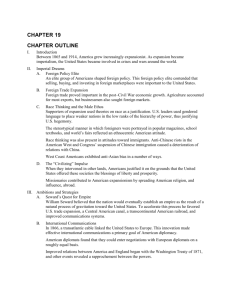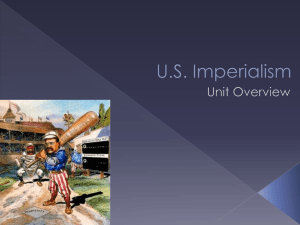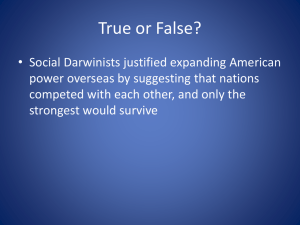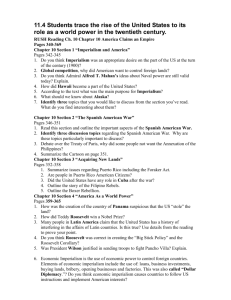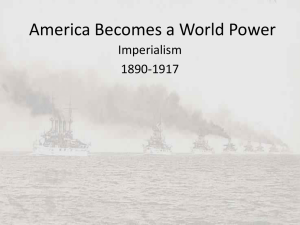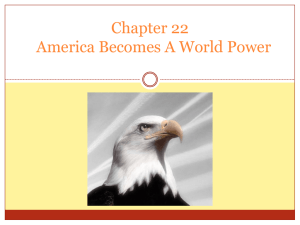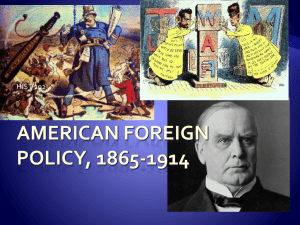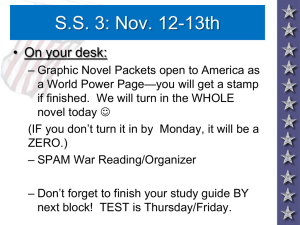Chapter 7 Notes
advertisement
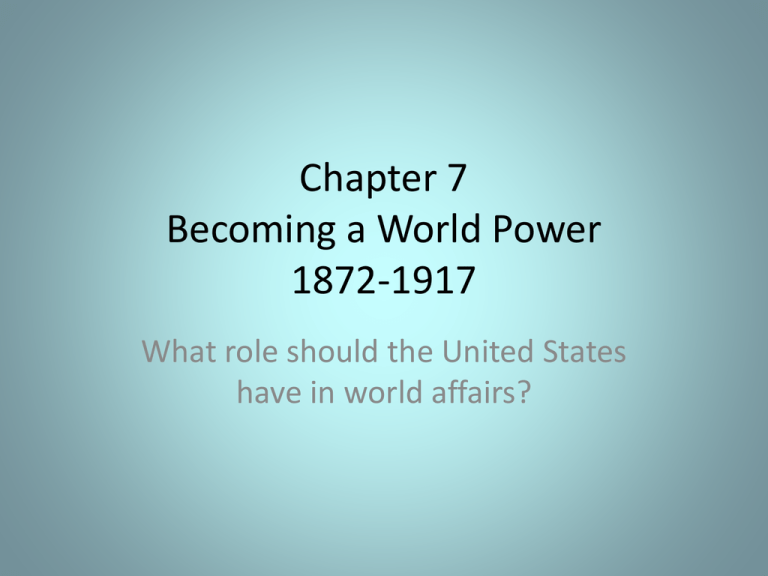
Chapter 7 Becoming a World Power 1872-1917 What role should the United States have in world affairs? The Imperialists Vision • Imperialism – the economic and political domination of a strong nation over weaker ones. • Why was the U.S. interested in becoming an imperial power? – Tariffs and trade – Raw materials – New markets – Colonies and protectorates – European expansion The Imperialists Vision, cont… • Social Darwinism – only strong nations will survive. • Anglo-Saxonism – English speaking nations had superior character, ideas, and systems of government. • Manifest Destiny – God given destiny to expand overseas and spread its civilization to other people. – Missionary work Imperialism Assignment • Read the Primary Source Documents (2 documents) and answer the questions at the end of each document. Imperialism Review * Working alone or in groups of 2 or 3, write a paragraph either defending American Imperialism at the turn of the century or arguing against American Imperialism. Refer to one or both of the documents, or to Section 1 of Chapter 7, to explain your opinion. Section 1 The Imperialists Vision, cont… • Powerful navy needed to protect merchant ships, trade routes, economic interests. • 1853 – America develops trade relationship with Japan. By 1890 Japan has developed its own powerful navy and is creating its empire in Asia Section 1 The Imperialists Vision, cont… • Hawaii – Sugar – and the Marines – 1819 - Christian missionaries arrive from New England. – 1850’s - American settlers discover sugarcane grows well. – 1887 – Wealth planters pressure King to accept constitution which limits his power. – 1890 – Congress passes tariff making Hawaiian sugar expensive. – 1891 – Queen Liliuokalani takes throne, tries to reassert power of monarchy. – 1893 – Wealthy planters and U.S. marines force her out. – 1898 – U.S. annexes Hawaii Section 2 The Spanish – American War • Cuba was a valuable colony for Spain and produced 1/3 of the worlds sugar. Until 1886, Spain enslaved nearly 1/3 of all Cubans and forced them to work on plantations. • 1868 – Cuban rebels declare independence from Spain but revolution fails. • U.S. develops strong economic ties with Cuba • 1895 - Cuba declares its independence from Spain again. • U.S. remains neutral. Section 2 The Spanish – American War, cont… • America Supports Cuba – American Revolution – Yellow Journalism – Newspaper owners William Randolph Hearst and Joseph Pulitzer – 200,000 Spanish troops arrive – General Weyler (the butcher)appointed governor – Rebels destroy American property in Cuba – Tens of thousands of Cubans die of starvation and disease while held captive in “reconcentration camps”. Section 2 The Spanish – American War, cont… Calls for War • U.S. tries to remain neutral • Spanish Ambassador calls President McKinley weak. • USS Maine sent to Havana Harbor to evacuate American citizens • 2/15/1898 – Maine explodes and is sunk. Cause unknown. • Congress authorizes money for war. • jingoism – extreme nationalism very high • Political pressure moves McKinley to ask Congress to declare war. The War Begins and Ends • May 1, 1898 - Commodore George Dewey destroys Spanish fleet in Philippines. • June 14, 1898 – American troops land near Santiago. • Teddy Roosevelt and the “Rough Riders” attack Kettle Hill and San Juan Hill • July 3, 1898 – Spanish fleet is destroyed in Cuba. • Late July, 1898 – Spanish troops in Cuba surrender. Section 2 The Spanish – American War, cont… • An American Empire – Cuba gained its independence (limited) – Guam and Puerto Rico annexed by the U.S. • Inhabitants eventually gain U.S. citizenship – After much debate, the Philippines are annexed. • Philippine rebels who fought against Spain now fought against U.S. • U.S. used “reconcentration camps” like Spanish in Cuba. • Tens of thousands of Filipinos died from combat, disease, or starvation. • 1946 – U.S. finally grants independence to Philippines. Section 2 Assignment • Using information from Section 2, write a paragraph arguing in favor of or against American intervention in Cuba in 1897. • Read the arguments on page 273, for and against the annexation of the Philippines, and read The Debate Over Annexation on 273 and 274. Use this information to write a paragraph in favor of or against annexation of the Philippines. Section 3 New American Diplomacy • Asia – The U.S. was a major power with many naval bases across the Pacific. • Many European countries were exerting control over trade with China. • President McKinley and Secretary of State John Hay created the Open Door policy, whereby all countries would be allowed to trade with China. • Some secret Chinese organizations rebelled against the foreign control and started the Boxer Rebellion. • After 200 foreigners were killed, 8 countries including the U.S. sent troops to China and put down the rebellion. Section 3 New American Diplomacy, cont… • President McKinley is assassinated in Buffalo, New York by an anarchist. Teddy Roosevelt takes over. • Roosevelt believed in American power and AngloSaxonism. • Roosevelt was instrumental in ending a war between Japan and Russia. • Roosevelt was famous for his saying of “Speak softly and carry a big stick.” The Panama Canal Section 3 New American Diplomacy, cont… • The Panama Canal – – – – – Roosevelt believed it was vital to American power. A canal would save time and money. Nicaragua and Panama were considered good options. Panama became best option. U.S. offered Columbia $10 million and $250,000 a year to build through Panama. Columbia refused. – Some Panamanians used this as an opportunity to get their independence from Columbia. – Roosevelt sent 10 warships to the area. – The U.S. recognized Panama’s independence and a treaty to build a canal was signed. The Panama Canal Section 3 New American Diplomacy, cont… • The Roosevelt Corollary – The U.S. would intervene in Latin American affairs when necessary to maintain economic and political stability in the Western Hemisphere. • Dollar Diplomacy – Roosevelt’s successor, William Howard Taft’s policy of using American economic power to help Latin American development.



